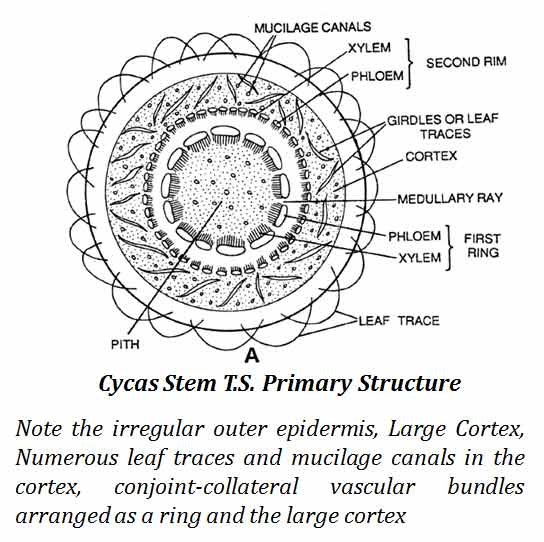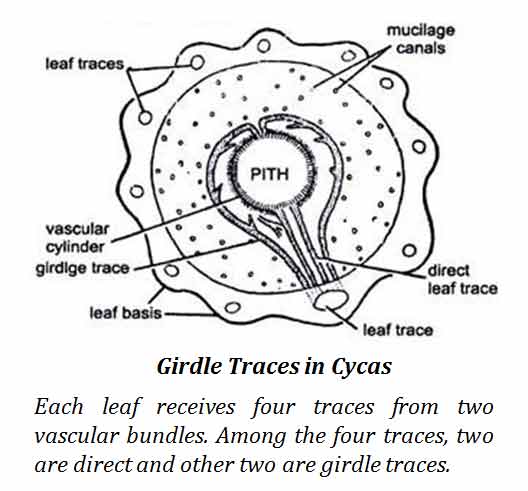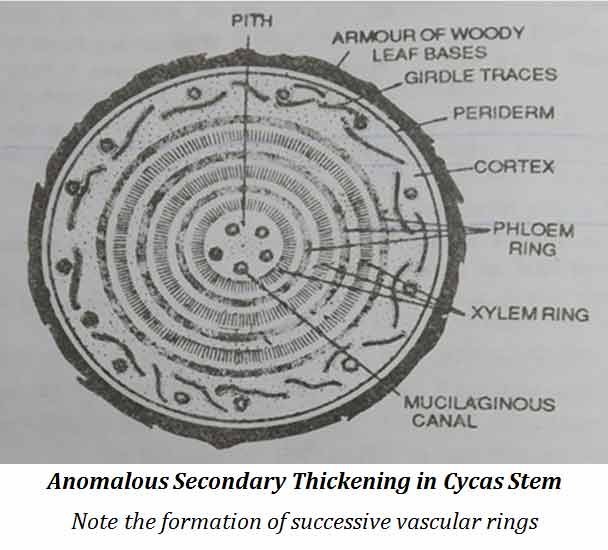Part – 2: Anatomy of Cycas
<<< Part 1 —- Part 3 >>>
Anatomy of Cycas
Cycas Stem Primary Structure
Ø Anatomy of the stem of Cycas resembles that of dicot plants.
Ø The T.S. of the stem is irregular in outline due to the presence of persistent leaf bases and leaf scars.
Ø Cortex very large and composed of loosely packed parenchymatous cells.
Ø Vascular tissue consists of many vascular bundles arranged as a ring.
Ø Each vascular bundle is open and endarch.
Ø The Pith very large and parenchymatous.
Ø Many mucilage canals and leaf traces present in the cortex.
Ø Cortical and pith parenchyma contain plenty of starch grains.
Ø Numerous leaf traces are present in the cortex of Cycas.
Ø The Leaf traces in Cycas are called as girdles (or girdle traces).
Ø Leaf traces are concentric and mesarch.
Leaf Trace (Girdles) in Cycas
Ø Cycas shows girdling of leaf traces, as explained below.
Ø Parenchymatous leaf gaps are present in Cycas, hence leaves are macrophyllous.
Ø Each leaf receives FOUR supplies from TWO vascular bundles from the stem.
Ø Each leaf receives FOUR traces (from two vascular bundles).
You may also like: Cycas PPT (Download)
Ø Among the four traces, two are direct, the other two passes around the stem though the cortex (these traces are called girdle traces)
Ø Leaf traces are concentric and endarch when they start and mesarch when they pass out the cortex.
Ø Due to this particular girdling pattern of leaf traces, we can see plenty of leaf traces in the cross section of the stem of Cycas.
Ø The presence of concentric bundles is a Pteridophytic character which shows the affinity between Cycas and ferns.
Secondary Thickening of Cycas Stem
Ø Secondary thickening is present in the stem and tap-root of Cycas.
Ø Cycas shows Anomalous Secondary thickening in the stem.
Ø The first cambial ring (formed by the fusion of fascicular and inter-fascicular cambium) stays active for a short period time.
Ø This cambium cut secondary xylem towards the inner side and secondary phloem towards the outer side.
Ø After a short time, a new discontinuous cambial ring is originated outside the secondary phloem.
Ø The second cambium then cut secondary xylem and phloem for some time and then it also perishes.
Ø This process is repeated throughout the lifetime of Cycas.
| You may also like NOTES in... | ||
|---|---|---|
| BOTANY | BIOCHEMISTRY | MOL. BIOLOGY |
| ZOOLOGY | MICROBIOLOGY | BIOSTATISTICS |
| ECOLOGY | IMMUNOLOGY | BIOTECHNOLOGY |
| GENETICS | EMBRYOLOGY | PHYSIOLOGY |
| EVOLUTION | BIOPHYSICS | BIOINFORMATICS |
Ø Thus, secondary xylem and phloem are produced in successive rings. The older ring will be inner and the younger one will be outer.
Ø The growth pattern is NOT annual in Cycas and hence these rings are NOT annular rings.
Ø They can be called as just growth rings.
Ø The wood of Cycas is manoxylic type
Ø Manoxylic wood: A wood with large amount of paranchymatous cells.
<<< Cycas Part 1 | Cycas Part 3: Anatomy of Root & Coralloid Root >>>
| You may also like... | ||
|---|---|---|
| NOTES | QUESTION BANK | COMPETITIVE EXAMS. |
| PPTs | UNIVERSITY EXAMS | DIFFERENCE BETWEEN.. |
| MCQs | PLUS ONE BIOLOGY | NEWS & JOBS |
| MOCK TESTS | PLUS TWO BIOLOGY | PRACTICAL |




Very much helpful for my exam